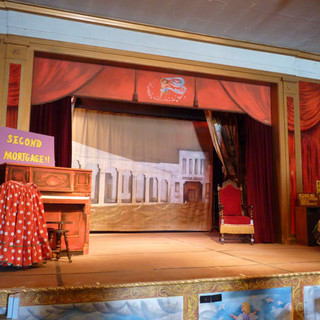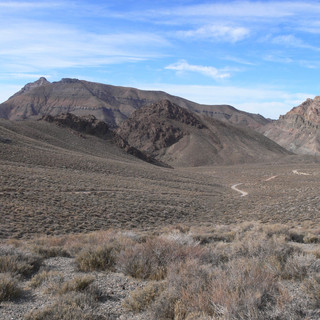The East Side of Death Valley
- Shanghai Brown
.JPG/v1/fill/w_320,h_320/file.jpg)
- Feb 24, 2019
- 8 min read

One of my favorite places to road trip is the eastern side of Death Valley National Park. The area is filled with incredible vistas, natural beauty, history, and off-beat attractions. You can enjoy a rattlesnake pizza, or a dessert with a real scorpion in it, sip a local brew, hike along the Amargosa River, wander an enchanted oasis, ponder life for miners living in homes carved out from the rock, or catch a performance at a legendary opera house and stay in its (supposedly) haunted hotel.
Let me introduce you to some of my favorite places and things to do while exploring this part of California (and a little Nevada, while we're at it). We'll start at the "town" of Baker, on Interstate 15.
You will never find a more wretched hive of scum and villainy. We must be cautious.
- Obi Wan Kenobi either talking about Mos Eisley or Baker, California
Baker is of dubious origins, but probably began when someone figured out they could rip off travelers whose cars broke down. We paid a fairly astronomical sum for a tire there once. Nowadays, this dusty, windblown community serves as a pit stop for Vegas-bound (or returning) travelers coming from Los Angeles and southern California. While I greatly prefer taking the back road to Vegas, most southern Californians are more eager than I to get to Vegas, lose money, and drink truly awful three-foot high drinks, presumably puking them up either in their rooms, or the gutter of the Strip.
But Baker is, nonetheless, a good place to gas up the jalopy, and grab a bite to eat. While the masses may be drawn to the overpriced mediocre "Greek" food over at the Mad Greek (I do love their decor), there's better food to be had over at Los Dos Toritos Mexican Restaurant. Make sure to check out the giant thermometer and buy some jerky from the aliens if you have time.
From Baker, head up Highway 127, with a tank full of gas that you got in Baker. Along the way, look for a rock/dirt road to the right to the Salt Creek Hills. You can see the wetlands that still exist here, and a few ruins here and there that were once part of a larger community. Yes, people once lived here, despite the odds. Now it is a BLM Area of Critical Environmental Concern, just south of the Dumont Little Dunes offroading area.
When you reach the Old Spanish Trail Highway turnoff to the east, follow it out to Tecopa, and then take Furnace Creek Road south until you reach China Ranch Road. Take that road down through a rough looking slot canyon and into the beautiful oasis that is the China Ranch Date Farm. Here, you can sample varieties of dates you can't find anywhere else (in the world), as well as grab the best date shake in the desert, date bread, date cookies, and, more dates! There are places to picnic, and you can stroll through the 1,600 or so date palms in this lush oasis.
There are some great hikes you can do from here, so if you have time, check their trail map and explore the Amargosa River Valley, follow the old Tonopah & Tidewater Railroad, or wind your way up a slot canyon. I think this whole area is extraordinarily beautiful, and well worth exploring.
After China Ranch, head back into Tecopa. There are places to stay here, ranging from campgrounds and Airbnbs, to the Tecopa Hot Springs Resort. The Tecopa Bistro is a great place to grab breakfast, lunch, or dinner, and yes, they're home to the rattlesnake pizza (must call ahead), and the scorpion dessert. The Tecopa Hot Springs Resort has nice private hot tubs and hotel rooms, as well as some fun activities on occasion.
But we're heading on, so we're going to go north on Tecopa Hot Springs Road until we reconnect with Highway 127. We'll head north again on Highway 127 until we reach the village of Shoshone, a tiny privately owned town with a lot to offer.
On the south end, as you enter Shoshone, to your left will be a pull out for the Shoshone Cemetery and Dublin Gulch. Both are worth exploring, as the history runs deep here. Dublin Gulch has the homes miners carved out of the tufa (rock formations) to live in around a century ago. You can see inside, and even go inside, some of these homes. If you want more of this sort of thing, take the Charles Brown Highway (178) eastbound out of town just until you see more of the tufa formations to the north. You can pull over and explore this area.
Back in Shoshone, you can get more expensive gas. shop the general store, visit the Shoshone Museum, or grab a bite or drink at the Crowbar Cafe, which has decent food. You can also stay at the Shoshone Inn, or pull the RV in at the Shoshone Trailer RV Park at the north end of town. I really like Shoshone, and we've seen a bobcat prowling the edge of the wetlands at the north end of town near sunset.
Just north of Shoshone you can turn off down Jubilee Pass Road and head into Death Valley National Park, but we're going to keep going up Highway 127 right now, though we'll be back this way soon.
The next "town" you'll encounter as you head north, is Death Valley Junction, an old mining town made famous when New York performer and artist, Marta Becket, found her destiny here in 1967. Marta and her husband were on a tour, performing across the country, and camping in between performances. Their trailer got a flat tire while camping in Death Valley National Park, and Death Valley Junction was the nearest place to have the tire patched.
While waiting for the tire to be fixed, Marta explored the old headquarters complex for the mining company and found an abandoned auditorium. As she gazed through a window into the interior, she realized this was where she would perform for the rest of her life.
A legend was born.
Marta returned to Death Valley Junction after her tour, rented the hall (and later purchased the entire town), and began performing, sometimes to no one at all. She resolved that issue when she spent over three years painting the interior of the auditorium, transforming it into scenes of a night at the opera. There is royalty, courtiers, clergy, socialites, courtesans, and more, all from the 16th century, caught in the act of the excitement of a night at the opera. It now seats 110 people and folks come from around the world just to see the theater, though the best thing is to catch a performance there.
Marta died a couple years ago, but her nonprofit organization is working hard to build on her legacy. The 2018-19 season is the 51st season for the Amargosa Opera House, and the performances offered there on weekends during season are superb (I'm biased, however, performing here two weekends in March, 2019).
There's also a hotel and a fantastic breakfast/lunch cafe on site here. The Amargosa Hotel is supposed to be haunted, but we stayed two nights in Room #9, which is supposed to be the most haunted room, and the only thing that haunted us was the snoring from the other room (though I may have been just as bad - but I was asleep and couldn't say for sure).
If you stay here, look for Marta's herd of wild mustangs early on in the morning. They still come down for food and water here, and it's a great opportunity to see them close up. But if you miss them in the morning, keep an eye out for them running across the desert in the distance.
You can reach Pahrump, Nevada, if you take State Line Road east from Death Valley Junction, or just north of town, you can take Highway 190 westbound, into Death Valley National Park, to Zabriskie Point (great for sunsets), Furnace Creek, the Oasis at Death Valley (the old Furnace Creek Inn, with a horrid new generic name that lost all the Inn's history), and the loop from Furnace Creek south to Badwater, the Devil's Golf Course, the Artist's Pallette, a host of other places to explore, returning back to Shoshone on Highway 178.
There are great places to stay (if you have money) at Furnace Creek, and places to camp too. There's some food available there, and expensive gas. If you've come up to Death Valley from Baker and want to head home a different way, seeing more of Death Valley National Park, then you can go north from Furnace Creek up Highway 190 past the Mesquite Sand Dunes to Stovepipe Wells (hotel, restaurant, general store, and expensive gas), and follow it around through some dramatic passes, to Panamint Springs (hotel, restaurant, store, expensive gas), eventually arriving in Olancha on Highway 395. It's a mesmerizing, if somewhat longer, drive.
Back on the east side of Death Valley National Park, if you head north on Highway 127 from Death Valley Junction, you'll cross the California-Nevada border soon, and you'll come to the Longstreet Inn Casino and RV Resort, with good accommodations, cafe, bar, and the Big Bovine of the Desert! The highway turns into 373 in Nevada, but not long past Longstreet, you'll come to a turnoff to the east to the Ash Meadows National Wildlife Refuge. It's a fantastic place to explore, where streams of water mysteriously appear in the desert. You can find pupfish here, including the famed Devil's Hole pupfish in the Devil's Hole portion of Death Valley National Park, located here at Ash Meadows.
Keep heading north on Highway 373, and you'll come to the Amargosa (Valley) Junction, with Highway 95. Here you'll find the Alamo Fireworks stand (where you can set off the fireworks if you want), the Area 51 Alien Center (which last time I stopped had a cafe and a whorehouse), as well as a gas station/convenience store that may be open now.
If you find yourself at the junction, you may as well head north to Beatty, Nevada, a fun little town with lots to recommend it (honest). Drop by the Happy Burro for chili and beer, and ask them about the haunted (and abandoned) whorehouse back by them. There are several hotels here, none remarkable as far as I can tell, and some other restaurants that put out pretty decent grub.
Speaking of burros, as you head west out of Beatty on Highway 374, keep an eye out for wild burros. We encounter them in the area frequently, and some creep has been killing them. I swear, I don't know what's wrong with some people.
Southwest of Beatty, to the north of the highway, you come to a great place to explore (really two places). First, you'll notice signs of a lot of mining activity. Then, you'll see some pretty large, crazy looking, artwork. That's the Goldwell Open Air Museum, with some impressive art installations to enjoy. When you're done there, you're not done. Keep going north on the road into the ghost town of Rhyolite. It's a fantastic place to explore, with a lot of history. Rhyolite didn't last long, but it sure tried to make itself impressive while it was here. As always, be respectful of historical sites, don't take things, vandalize things, or carve/inscribe your name or anything else on buildings or other facades.
If you continue southwest down Highway 374, you have two ways to get into Death Valley National Park. The first is only applicable if you have plenty of gas, and a high clearance, preferably 4WD (doesn't have to be - usually) vehicle. That would be the Titus Canyon turn off, which is a magnificent one-way drive into Death Valley National Park through dramatic scenery, petroglpyhs, another ghost town, and a slot canyon you drive through (one reason why it's a one-way road). If you have time and the right vehicle, with gas, water, and food with you, then this is a memorable trip.
If you aren't prepared for Titus Canyon, however, don't attempt it. Instead follow the highway through Hell's Gate and come down and reconnect with Highway 190. Head east for Furnace Creek, or west for Stovepipe Wells.
There's much more to see and do in this area, but I don't want to overwhelm, but rather entice and let you make your own discoveries. There's more than enough to do to enjoy a long weekend, or a lifetime, out here. Always check road conditions before you go - flash floods can mess up desert roads pretty bad.
Oh, and one more thing. Wildflowers. As I write this in February, 2019, it looks like now that the rains and snow have passed, things will be quickly warming up out this way, and the wildflowers will start to arrive in force. Death Valley is warm enough that we should begin to see good wildflower blooms from March into April, so come on out!
















































































































































































































































































































































































Comments